|
Third in a Soap Lake Centennial series featuring Soap Lake Entrepreneur and Former Mayor, Marina Romary  In 1969, Marina Romary left her job at Moses Lake’s Porterhouse Restaurant. Moses Lake’s loss was Soap Lake’s gain. The Soap Lake Businessmen’s Club was in trouble; patronage had slipped; and the Club’s manager, Doyle Rushton, was tired. Within weeks of landing back in Soap Lake, Marina was appointed the new manager. Within a year, she’d purchased the Club-- beginning a nearly 50-year tenure of colorful ownership. "When I got involved with the Club it had been going since, I think, the early 1950’s. When they started the Club, it was closely associated with the Lion’s Club, which was very influential in Soap Lake. The businessmen met downstairs. They’d bring their own liquor and the Club would provide mixers and ice. In its heyday, they had slot machines against the wall and five or six gambling tables. It became a hot gambling spot until everybody went to jail. The things that went on in Soap Lake in the 1950’s—well, let me just tell you, it was the party town of Grant County."  An important reason that Marina was able to return the Businessmen’s Club to its former glory was the effort she spent securing good entertainment. She began hiring talented folks from Central Washington and quickly moved on to nationally known groups and singers. "My first entertainer was Stan’s Jazz out of Wilson Creek. 'One more time!' He always said that. It’d be twenty after two in the morning and, 'One more time…!'. He played the trombone and his kids and wife were the rest of the band. They were a wonderful group. I first saw Billy Nickels leaning on a lamppost on the street next to the Club. He says to me, 'I’ll do your music for a hamburger'. 'You’re on', I said, and he played the Club for years. Slim Dossey was also a great guy. He played at every dinner we had in the back yard. He was an old timer—he knew all the old songs—and people really enjoyed him. Hank Thompson was another of my favorites. He drew the biggest crowd we ever had in the Banquet Room, He loved us; he just loved us." An early entertainer who Marina brought into the Club was a Burl Ives impersonator. He stayed—as did all the out of town entertainers—in a small place Marina called The Music House. One day, when Marina and he were visiting, he remarked that Bonnie Guitar would love playing Soap Lake and staying at the Music House. At about the same time, Grant County cattleman Ken Ardell, who knew Bonnie from rodeos in Auburn, was talking her up to Marina. So, Marina took a leap and contacted the famous country singer. Soon Bonnie was playing the Club, staying at The Music House, and the rest is Soap Lake history. "Bonnie was an idol of mine and so here she comes the Club. She loved it, she really did. In the beginning, she was playing five nights a week—then we went to three nights—then we went to weekends. But, she was my house band for 13 years. She lived in that little Music House. We had lots of great acts during that time, but I did have my favorites. The Ink Spots—they loved it here. They almost lived with me. We had an Elvis impersonator—he was always a good show. And, when The Hager Twins from Buck Owen’s 'Hee Haw' played the Club, well, that was a really good time." Great entertainers weren’t the only entertainment at The Businessmen’s Club. Mud wrestling drew large and enthusiastic crowds. "The pit was in the empty lot behind Notaras Lodge. We mixed mud from the lake with clay mud. We even brought in stadium stands for it. Donny Merrill was the event announcer. A lot of people mud wrestled and a lot of people did a good job. The contestants were all of Soap Lake’s young people. Mike Arvan’s daughter was a tough fighter—as was my daughter, whom I actually wrestled. And then people would just show up to wrestle. We had a rodeo queen—I think she was from Omak—she was tall and strong. She did a good job. Both men and women wrestled. But, except for me, we never had the men wrestling the women. We kept that separate. I did, however, mud wrestle the Chief of Police when I was mayor. Dick Robinson was Chief then, and he won the first round. So, the next round, I poured a bunch of olive oil all over me and shocked Dick by running through the mud and jumping on him. I did; I jumped on him. I got him and I scared him to death—and I won that round! Then, he got himself back together and he won the next round. Everyone had lots of fun for the three or four years we mud wrestled at the Club." The Hooker’s Ball was an annual Halloween Event at the Club. For a time, it was wildly popular with folks from all over the state of Washington coming to Soap Lake to party.
"We did it for five or six years. The women would dress as hookers—furs, sparkly jewelry, sexy clothes--and the guys would be suave. It was just a great time—a Halloween costume party. The idea came up first from our young bartenders sometime in the early 2000’s. We actually had a little pushback; we did get feedback—not all good. But, I loved the idea enough to do it. And people loved it enough to come from the Coast—from all over our area—and pack the Club. Eventually, an idea like that wears out—and that one did, too. But, we did have some great times." How quickly a half century can pass. By 2015, Marina found herself as tired as Doyle Rushton had been 50 years earlier. It was time to sell all of her historic Soap Lake businesses, the Businessmen’s Club among them. "Those were hard days. I was tending bar at the Club because it was hard to keep somebody there. I was cooking in Don’s kitchen because my sister, April, was gone. My daughter was coming from the Coast three days a week to help me, and that was killing her. It sadly became clear that it was time to sell."
1 Comment
Second in a Soap Lake Centennial series featuring Soap Lake Entrepreneur and Former Mayor, Marina Romary The Notaras Lodge is deeply rooted in the history and tradition of Soap Lake. It sprang from the creative mind and muscle of Marina Notaras Romary—daughter of city pioneers, George and Joyce Bender Notaras. George and Joyce ran the Lakeside Cabins and Hotel, located just across the street from the James Cafe. It was there that Marina—and her six siblings-- grew up and where compelling memories were made: "When my dad came to Soap Lake, he bought the Lakeside Cabins and Hotel. As I was growing up, that hotel building was everything. It was a pool hall, a card room, a plumbing shop, a tavern, and of course, a place out back where we could get ice cream cones. I grew up knowing how to do thirty sheets on a line, perfectly hung. When the clothes line was in the right place—the sheets dried in 10 minutes in the Soap Lake sun."  James Café —Notaras family collection Second from left: Joyce Notaras; fourth from left: John Pappas; fifth from left: Jimmy Arvan  It wasn’t until 1983—after great success with Don’s Restaurant and The Businessman’s Club--that Marina found her chance to put her family back into the lodging business. There had been a log home built in Moses Lake. "I read about it in the newspaper and I went to see it. When I walked down the massive stairs I told the log man, Norm Rolf, 'Boy, I hope you can do this for me sometime." So, when he finished that house, he came out to the Businessmen’s Club. We had a bottle of Cutty Sark that we were drinking that night. When we finished that bottle—we just went out and started digging the hole for the Lodge. "Bonnie Guitar and I went up in the mountains above Winthrop and bought 300 logs out of a fire burn. They’d been debarked and had been standing dead for 12 years. I had a black man working for me, Tommy Thompson. He had muscles as hard as this table. He hewed every log in the Lodge—not just the main building, but the whole place. Tom-Cat we called him.  Over the years, my brother in law, Jim, helped me a lot—as did my friend, Kurt Graham. There was so much work to do. "My log men were special to me; they were out of Alaska and they were a real motley crew. They lived at the building site; they ate there; they played there. Usually, they’d just cut the logs down to fit. But, I said, why don’t you just leave the cuttings for me—I could make a table or something. So, they left them and I made tables into which I would epoxy Soap Lake memorabilia. We furnished a lot of that hotel with those tables."  The Notaras Lodge was famous for its themed rooms: the Bonnie Guitar Suite; the Norma Zimmer room; the John Wayne room; the Greek Sunroom; the Ben Snipes and Charlie Russell Rooms; the Outlaw Room and The Sagebrush Annie Room. "When the logs were about half way up, Bonnie Guitar’s daughter, Paula, and I climbed a ladder one night and went over the top. We were standing at the north corner of the Lodge, and she says, 'Marina, why don’t you name your rooms.' I said, 'What a great idea. Let’s name this room the Bonnie Guitar Honeymoon Suite.' And, then, the whole idea just took off. One day, I remember, I was sanding logs and here comes KXLY TV from Spokane. I showed them the Bonnie Guitar suite. I had been fixing the bed to play Dark Moon whenever anyone climbed into it. The reporter says to me, 'What if you can’t get it done?' And, I said, 'Well, I’ll just put Bonnie under the bed!' And what do you know, they put that on TV!"  The John Wayne Room and the Greek Room brought back more fond memories for Marina: "I had a swing in the John Wayne Room with a seat covered in lamb’s wool. I remember that Melody Arvan brushed that seat for eight hours one day—an entire shift. I never did learn the stories of that swing—but, I am sure there were some! The Greek sunroom was all windows with specialized glass so that you could sun bathe through them. There was also a Pac Man machine so you could tan and play Pac Man. The guests just loved it. I had all my mom and dad’s stuff in that room—much of it epoxied into the tables. It was all so beautiful.  In 1998, the main building of the Notaras Lodge burned down. It was a devastating blaze caused by a flawed relay switch in the Bonnie Guitar suite. "After the fire—it was hard. The logs in that main lodge building werespecial to me. Someone suggested that I should just sand the burn off of them. "But, it wasn’t a reasonable job, so we took the building down. I had two more log buildings already built and I was working on another. So, I took the fire money and finished that last building. The foundation for the building that burned is still there. I don’t know if the new owners will ever build on it or not, but, it could be built on. That fire was a major one for me in so many ways." With this loss, the main building of the Notaras Lodge joined a parade of Grant County buildings lost to fire. In Soap Lake itself, the Lodge was preceded in fire by the famous blaze at the Siloam Hotel, a fire at the Lakeshore Cabins, and a fire at Marina’s own Businessmen’s Club. In this and many other ways, the Notaras Lodge has stood a proud legacy to the many storied lodging establishments of Soap Lake’s past. Memorial Day, 2019 Valley View Memorial Park, Soap Lake, WA Research by Linda Lannigan Bonneville and Sharon Hastings Presented by Jesse Huntwork We gather here today to honor those brave Americans who have given their lives for our country. I am honored to tell you stories of military heroes—as well as other Soap Lake residents who served in their own way, working and raising their children or healing and ministering to their neighbors. But first, let me share a bit about this beautiful cemetery. Valley View Memorial Park’s original 5.2 acres was platted on July 25, 1955. Later, additional land was donated by Madoline McNamara, who moved to Soap Lake in 1949 with her husband, Dr. Leonard McNamara and their two young children. Leonard and his brother, John, were respected physicians in our community for many years. Old records state that neighbor and friend, Larry Scheib, began clearing the sagebrush on the additional 1.5 acres until a tragic airplane accident in 1961 claimed the lives of both Larry and Leonard. One of the beautiful statues at this cemetery is Our Sorrowful Mother. It was dedicated by Bishop Carlos Sevilla in 2000, in remembrance of Soap Lake’s Our Sorrowful Mother Catholic Church, destroyed by fire in 1996. 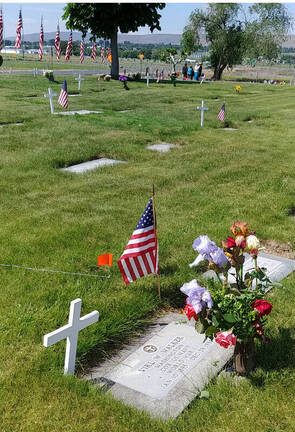 Four months later, in January, 1956, Virl W. Walker became the second person interred at Valley View Cemetery. Virl was born in Arkansas in 1895 and moved to Texas as a young child. He served four years in the Navy during the First World War. In 1938, Virl and his wife Ida moved to Soap Lake. As we researched Virl’s life, we asked the question: why did Virl and Ida move from Texas across the country to Soap Lake, WA? One clue: Virl was a WWI veteran. Many WWI soldiers suffered from Buerger’s Disease, the inflammation of small and medium blood vessels. During those years, many patients suffering from this debilitating disease vacationed at Soap Lake, soaking in the therapeutic mineral water and mud. Many visitors decided to make Soap Lake their permanent home. When we contacted Virl’s family in Texas and Ohio, they verified that Virl did indeed have Buerger’s Disease. In fact, he lost an arm and a leg to the disease. His great-niece recalls stories about his hunting expertise, despite missing two limbs. He lived in our city until his death in December, 1955. Ida remained a Soap Lake resident until she passed 40 years later.  The earliest birthdate in this cemetery represents the life of Arvine Joseph Sanborn. Joe was born in Michigan in 1863. He owned a saw mill in Chehalis before moving to Soap Lake. He and his wife Clara lived with his nephew, Freely Sanford, who was the postmaster in Grant Orchards. Joe purchased land nearby in 1917 and farmed for over 30 years. He died in 1957 at the age of 94. There are 10 headstones in this cemetery with death dates occurring before the park’s 1955 opening. We believe the remains of eight individuals, who passed between 1920 and 1945, were moved from other locations.  The other two early headstones recognize individuals who were laid to rest in another state or country: Evelyn Hadley Lannigan and her twin, Lillian Christine, were born two months premature in 1909. Evelyn lived for 83 years but her twin lived for only 24 hours. Evelyn’s stone, here at Valley View Cemetery, also recognizes her sister who lies in an unmarked grave in Oklahoma.  Sergeant Cosmo Rex Barnes also rests thousands of miles away from this cemetery. Rex served our country in the Philippines during World War II as a Sergeant & Nose Gunner on a B-24J named "The Horrible Monster" in the 864th Bomber Squadron. On January 25, 1945, his crew took off from Tacloban Air Field for a bombing mission. His plane tragically crashed and burned on Samar Island shortly after takeoff. Sergeant Barnes was awarded the Purple Heart and laid to rest in the Manila American Cemetery, Philippines. The Manila American Cemetery contains the largest number of graves of our World War II military, a total of 17,058, most of who lost their lives in New Guinea and Philippines operations.  You will find Sergeant Barnes’ memorial stone, along with young Donna Erkela, Buerger’s Disease patient Virl Walker and farmer Joe Sanborn, in the Garden of Devotion, marked with helium balloons. 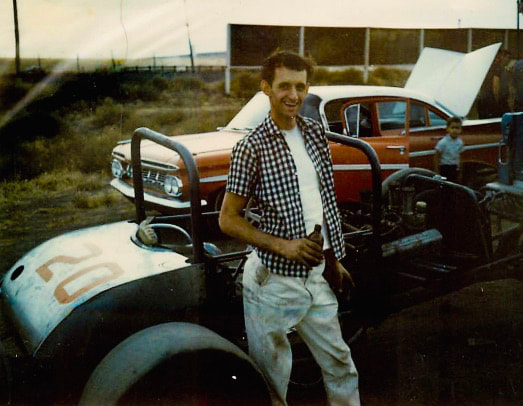
The need for speed. It was a contagion across the U.S. in the 1950’s and ’60’s, and Soap Lake, WA, had it bad. From the early 1950’s to the very early 1970’s—the Soap Lake Speedway revved the town on Saturday nights with the sounds and excitement of stock car racing.
Mike Arvan was a local kid who fell hard for car racing. One of seven brothers (and one sister), Mike remembers all the Arvan boys working in Soap Lake gas stations. Mobil, Flying A, Chevron, Union 76, Phillips 66, Exxon, the town had them all. Mike figures he himself worked in “darn near all of them”. But, it was at Larry’s Body Shop where his racing fever really hit. Larsen Air Base at Moses Lake was at full strength in those days, and Mike recalls that a lot of those guys were at Larry’s building stock cars. Mike spent much of his own spare time hanging out at Larry’s. The Soap Lake Speedway predated Mike Arvan’s racing involvement by several years. He remembers as a kid of five or six watching cars race on Soap Lake’s original dirt track located out where Shady Acres is now. About 1947, they moved the track to the site of the old Soap Lake Rodeo grounds. Mike recalls that, “all they had was a post and a cable between the grandstand and the cars.” But then, the whole operation went big time in 1953 when they laid an asphalt track. The effort was spearheaded by The Soap Lake Lion’s Club. The Columbia Basin Racing Association sponsored the races. The speedway was a quarter of a mile asphalt track with a steep bank—very steep. The track was egg shaped, not totally oval. One corner was a lot tighter than the others. It made for a tough racing challenge. There were bleachers and concession-stands—all new. The grandstand side of the track was banked, but the other parts of the track were pretty level. Mike reports, “you could go off the track pretty easy at the east end right where the school is right now. Pretty exciting at times.” The grandstands had a capacity of about 700 and they were regularly filled to capacity. Because of the large number of tourists summering at Soap Lake, nearly half the fans were usually from the west side of the state. The stock cars raced most weeks on Saturday nights. During early weeks of spring and fall, however, nighttime temperatures would be cool. So, races ran on Sunday afternoons. Normally, Mother’s Day opened the season and Labor Day weekend concluded it. On a typical Saturday night, three different classes of cars would compete: 1. “C” — Claimer class. A driver would run his (inexpensive) car in a C race. Anyone (not a racing association member) could then claim the car for $100—minus the tires and fire extinguisher 2. SS — Super stock class— models between 1951-1961. Engines had to be the same brand as the cars and the cars were required to be full bodied and entirely American made. Tires could be any size. 3. “A” - Modified class. These cars were handcrafted and the “A” Races were the ones fans really came to see. Engines had to be 280 cubic inches. These cars would sometimes reach 90MPH on the quarter mile Soap Lake track There were trophy dashes for each class. Then, there’d be a couple heat races; then “B” mains, and then “A” mains. Four laps for a trophy race; 8-12 laps for a heat race; 25-50 for a main event—though on special weekends like Suds and Sun and Labor Day, the main event would be 100 laps. Purses were generally modest, but on big weekends, they could reach $1000. On race nights, drivers would just show up. They came from Spokane, Yakima, Ellensburg, the Tri-Cities and all the towns in Grant County. Soap Lake drew some famous drivers. Tom Sneva (Indianapolis 500 winner in 1983) raced at the Speedway along with his brothers, Jerry, Jan, Blaine, Ed (“Babe”), and their dad, Ed. Bruce Garber ( Mead, WA) was a regular at Soap Lake; Bruce had a ride at Indy in 1985.
There were some hard tragedies at the Speedway. Don Osborn was a successful and popular driver from Ellensburg. Reports the Grant County Journal:
Don Osborn from Ellensburg, racing hard, tried to bring his “8-Ball” car into a better position. He died almost instantly when his wheel went over the wheel of another car. He safety belt broke at the center, releasing the shoulder harness, and he was violently thrown from the car. The car itself repeated flipped end over end until it came to rest on its top. Osborn’s wife watched the split-second tragedy from the stands. There was speculation that Osborn’s seat belt—while meeting track standards—may have been too old.
Osborn’s was the second fatality at the Soap Lake Racetrack. Five years prior, Jan Steward from Grand Coulee was killed. Jan’s father, John, was driving at Soap Lake on the day of the Osborn crash. The race was an annual memorial event for his son.
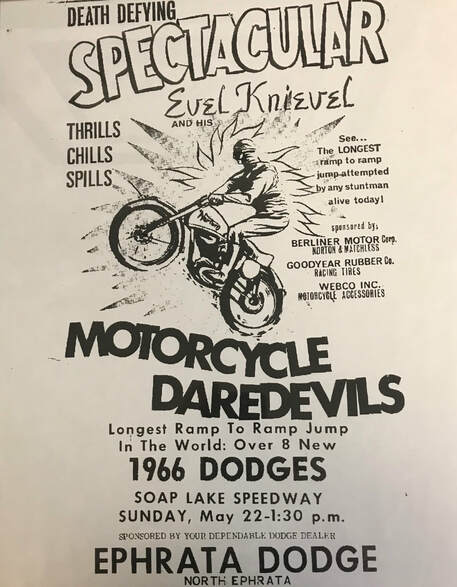
Infrequently, the Soap Lake Speedway would feature non-stock car entertainment. Evel Kneivel came to Soap Lake early in his career. The showman was in the midst of developing his death-defying act. In those days, Evel (born Robert Craig Kneivel) owned a Honda bike shop in Moses Lake. Mike Arvan describes him as a “down to earth guy— kind of a redneck. He’d leave that Honda shop every day in Moses Lake and wheelie all the way down Third Avenue. That’s the way he lived.”
Evel Kneivel performed at the Speedway Sunday, May 22, 1966. His act was promoted as, “the longest ramp to ramp (motorcycle) jump in the world, over eight brand-new 1966 Dodges”. The vehicles were provided by Ephrata Dodge. Mike Arvan describes the jump, “It was amazing when he came and set up for the show that night. The track was too short so he had to jump off the bank of the racetrack and come off onto the ramp. That night, he ran up to the top of the ramp, stopped and looked at the crowd—rolled all the way back— and made a couple of wheelies. Then, he rode up the bank, came off of it and down the ramp over all the cars.” While Knievel’s jumps later in his career involved many more vehicles and much more danger, the cocky showman was at his best that long-ago night in Soap Lake. Mike Arvan himself was no slacker in the thrills and spills department. Another (infrequent) fan favorite of the Speedway was The Wall of Fire. Mike describes his one and only performance: “I did one of them. You’d start a cardboard wall of fire. Then you’d ride on the hood and go through the firewall. I only did that once; that was enough for me! They’d advertised it, but no one came through to do it. So, I ended up doing it. It was just a shot at putting on a bigger spectator event to draw in an even bigger crowd.” Mike had a couple other major life experiences at the Speedway. The first was truly life changing: “My wife and I met through racing. I needed a trophy girl and she was walking down the street.” Recalls Margie about that time, “Mike didn’t win a race that day; I didn’t get to kiss him; I had to kiss his friend! Mike did his racing when we were young; mostly I remember being in the hospital having babies when he was racing. Every May we had one, it seems.” 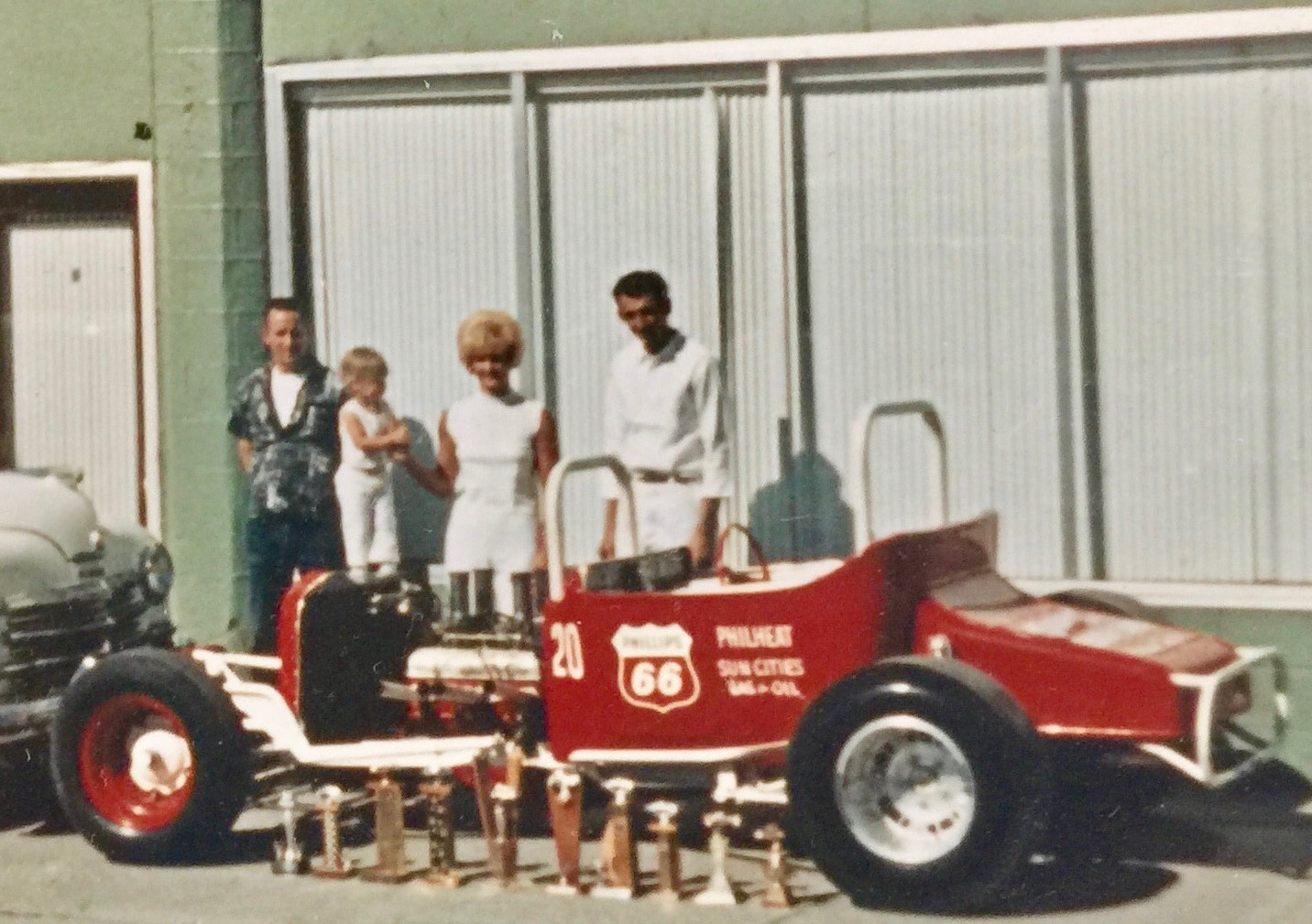
The other event was planned but turned out far differently than Mike and Margie and hoped: “I did have a really bad day racing. It was when I wrecked the car pictured in the photo. I had sold the car two races before the championship race with the agreement I could run it in the season championship. And then I totaled it. I remember I went airborne. There wasn’t much in the way of roll bars back then—just two. No arm restraints. Lots of broken ribs and other bumps and bruises. I didn’t get another ride after that; I quit racing. But, I pretty well had planned on quitting racing that night—it was the reason I sold my car.” Racing was a lot of work. Mike Arvan remembers working all day at the body shop (Dewey’s — promoted below in a famous Soap Lake photo of a two-headed 1947 Plymouth), and then a night shift at the Grant County PUD. In his spare hours, Mike would repair and ready his stock car for another night of weekly racing at the Speedway. 
The Soap Lake Speedway closed up shop because of an unusual reason: Mike Arvan explains, “The sewage treatment plant was right behind the race track; it got pretty smelly during the summer time. The city wasn’t about to change the location of the track, so the Columbia Basin Racing Association finally decided to build a track in Ephrata. When they built the Ephrata track, that was when the Soap Lake track closed.”
So ended Soap Lake’s love affair with fast cars and hot Saturday nights at the race track. To relive some of the magic evenings, check out the YouTube video assembled by Soap Lake historian and videographer, Kathleen Keifer.  Soap Lake’s historical buildings hold many human stories. One location, Lot 4, Block 1, Cottage City, better known as 19 South Division Street, has served the public since the 1920’s. We’re not certain when the Soap Lake Laundry was built. However, Washington State Archives show Alfred Oscar Gustafson granted the property to Peter Hampen in September, 1933 “in consideration for one dollar”. Gustafson, who remained a bachelor all his life, was born around 1877 in Sweden. The new owner soon opened Hampen’s Food Market. Hampen sold the business to Mike and Evelyn Lannigan in 1936. Lannigan’s Market served the community until 1950 when they build a larger grocery store next door. In 1960, they converted the grocery store into a laundromat. They operated the Dutch Girl Laundry until 1979 Mike Lannigan in Dutch Girl Laundry, November 1961  Years later, Nick and Freida (Notaras) Sebok purchased the laundry. Freida Sebok writes, “When I moved back to Soap Lake in 1980, there was no laundromat. But I met a Hungarian who was interested in repairing one that had been out of operation for years. His name was Miklos (Nick) Sebok. He was a man of all trades and in time all the washers were operating. We married and operated for several years with one helper who lived in back and oversaw the operation”. 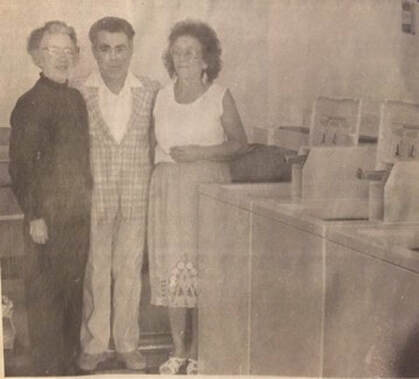 June, 1990 - Evelyn Lannigan with new owners, Nick and Freida Sebok Credits:
Washington State Archives, Central Region Branch Grant County Journal Ancestry.com Freida Sebok Linda Bonneville |
Archives
December 2019
Categories |


















 RSS Feed
RSS Feed
